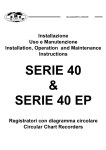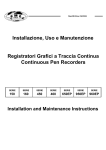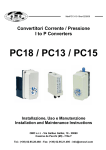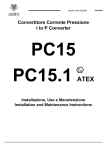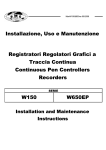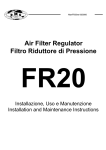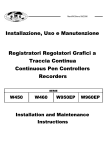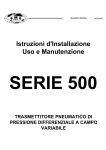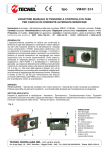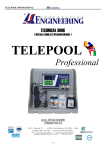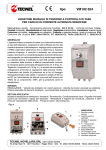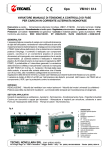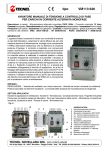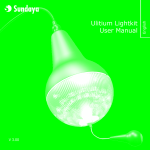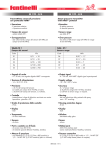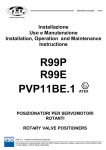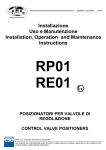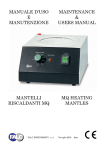Download Istruzioni d`Installazione Uso e Manutenzione Installation, Operation
Transcript
Man140EPne 09/2006 Istruzioni d'Installazione Uso e Manutenzione Installation, Operation and Maintenance Instructions SERIE 140 Registratori con diagramma circolare Circular Chart Recorders INDEX INDICE 1. INSTALLATION 1. MONTAGGIO 2. TECHNICAL DATA 2. DATI TECNICI 3. IDENTIFICATION 3. IDENTIFICAZIONE STRUMENTO 4. CONNESSIONI 4. CONNECTIONS 5. DIMENSIONI DI INGOMBRO 5. DIMENSIONS 6. FUNZIONAMENTO OROLOGI 6. CLOCK OPERATION 7. SCRITTURA 7. WRITING 8. CHART DISC REPLACEMENT 9. POTENZIOMETRIC CARD CONNECTIONS In case of mounting or operation problems, please contact our Local Agent or Service Department, Cernusco s/N (MI) - Italy. 8. SOSTITUZIONE DISCO DIAGRAMMALE 9. COLLEGAMENTI SCHEDA POTENZIOMETRICA In caso di problemi di installazione o di funzionamento, contattare il nostro Agente locale o il nostro Servizio di Assistenza Tecnica. OMC s.r.l. - Via Galileo Galilei, 18 - 20060 Cassina de Pecchi (MI) - ITALY Tel.: (+39) 02.95.28.468 - Fax: (+39) 02.95.21.495 - [email protected] Pag.2 1. MONTAGGIO 1. INSTALLATION Gli strumenti Serie 140 sono provvisti di quattro colonnine standard per l'immediato montaggio a quadro o a parete. Su richiesta viene fornita una staffa di montaggio per palina da 2" (verticale o orizzontale). Nota: particolare attenzione dovrà essere dedicata alla scelta del luogo più adatto al montaggio degli strumenti, per evitare che gli apparecchi siano soggetti a vibrazioni o si trovino esposti a vapori corrosivi, umidità, temperature ambiente oltre i limiti consentiti. The Series 140 instruments are equipped with four standard legs for direct panel or wall mounting. On request, a mounting bracket is provided for mounting the unit on a 2" tubing (vertical or horizontal). Note: particular attention must be paid to the selection of the mounting site, to protect the equipment from exposure to vibrations, corrosive vapors, moisture, or ambient temperatures exceeding the recommended limits. 1.1 Montaggio a quadro 1.2 Panel mounting Il montaggio a quadro avviene introducendo la cassetta in una apertura praticata nella lamiera del pannello e fissandola con le quattro colonnine e le apposite piastrine di riscontro (vedi Fig. 1.1). Insert the instrument housing into an opening made in the panel and fasten it in place by means of the four legs and the corresponding adapter plates (see Fig. 1.1). PANNELLO PANEL 224 Fig. 1.1 DRILLING R 1,5 192 LEGS COLONNINE PIASTRINE DI RISCONTRO ADAPTER PLATES 1.2 Montaggio a parete 1.2 Wall mounting Il montaggio a parete richiede la posa in opera di due profilati in ferro provvisti di zanche di fissaggio a muro. Fissare la cassetta con quattro viti passanti M6 da avvitare nei fori filettati delle colonnine di montaggio (vedi Fig. 1.2). Wall mounting requires the installation of two metal brackets provided with apposite legs. The housing is fastened to the panel by screwing four M6 screws into the threaded holes located in the legs (see Fig. 1.2). 212 179 10 20 MAX MAX VISTA FRONTALE PROFILATI BRACKETS FRONT VIEW Fig. 1.2 200 MIN Pag.3 2. DATI TECNICI 2. TECHNICAL DATA Grado di protezione - Degree of protection In alluminio pressofuso, verniciatura antiacida Die cast alumunium with anti corrosive paint IP54 Montaggio - Mounting A parete o a quadro - Wall or panel Connessioni elettriche - Electric connections morsettiera interna - inside terminal board Alimentazione elettrica - Electric feeding 24V 50Hz. (110/220V Optional) Consumo di energia - Power consumption 1 VA Segnali di ingresso Input signal ranges 4÷20mA 0÷20mA 1÷5V Deriva di zero per variazioni temperatura ambiente fra 0°C e 60°C Zero drift for changes of temperature from 0°C to 60°C < 0,15% / 10°C Diametro diagramma - Diameter chart 150 mm Ampiezza di Registrazione - Useful width 50 mm Rotazione Diagramma - Chart revolution 1giro / 24 ore (std) one rotation / 24 hours (std) Alimentazione Orologio - Chart drive 220V; 110V; 24V - 50Hz-Carica Meccanica-Batteria 1,5V 220V; 110V; 24V - 50Hz or 1.5V Battery or Spring tightening Limite di incertezza max. - Accuracy d 1% Isteresi - Hysteresis d 0,5% Linearità - Non linearity d 0,5% Ripetibilità - Repeatibility d 0,5% Limite temperatura ambiente Permissible ambient temperature -20....+ 80 °C Peso - Weight a3,5 Kg Custodia - Body and cover 3. IDENTIFICAZIONE STRUMENTO T.C.(mV). PT100 -100÷400°C Campo: 50°C min e 200°C max. PT100 -100÷400°C Span: 50°C min and 200°C max. 3. IDENTIFICATION I dati necessari all' identificazione dello strumento (modello, The recorder identification data (model, part number, matricola, alimentazione, elementi, scale, ecc...) sono supply, elements, scales, etc..) are reported on a plate riportati su una targhetta interna. located inside the instrument. 4. CONNESSIONI 4. CONNECTIONS Tutte le connessioni si trovano sul retro dello strumento. I The pneumatic connections are located at the rear bottom riscontri colorati in prossimità degli attacchi identificano of the instrument housing. The measuring element and the corresponding writing pens are identified by coloured l'elemento di misura e le rispettive penne scriventi. labels, situated near the connections. 5. DIMENSIONI DI INGOMBRO 5. OVERALL DIMENSIONS Fig. 5 Pag.4 6. FUNZIONAMENTO OROLOGI (vedi Fig. 8). 6.1 Orologio elettrico. Inserire i cavi di alimentazione dal retro dello strumento, facendoli passare nell'apposito pressacavo. Collegare i cavi al morsetto bipolare situato all'interno dello strumento. Collegare la Massa a Terra all'apposita vite. 6.2 Orologio a carica meccanica. 6. CLOCK OPERATION (see Fig. 8). 6.1 Electrical clock. Insert the feeders into the rear bottom of the instrument housing and pass them through the apposite cable gland. Connect the feeders to the bipolar clamp situated inside the unit. Connect the earth wire to the corresponding screw. Ruotare la ghiera zigrinata (1) (vedi Fig. 8.2) in senso 6.2 Spring tightened clock. antiorario sino alla completa carica. Turn the knurled knob (1) counterclockwise until the unit 6.3 Orologio a batteria. has completely been charged (see Fig. 8.2). Estrarre il disco disgrammale come descritto al paragrafo 6.3 Battery clock. 8.1, inserire la batteria stilo da 1,5V. Extract the chart disc as shown in paragraph 8.1. Insert the 1.5V battery. PENNA PEN PENNARELLO CARTRIDGE 7. SCRITTURA 7. WRITING 7.1 Cartucce scriventi. 7.1 Writing cartridges Gli strumenti vengono forniti con i pennarelli già inseriti sulle rispettive penne. Per la messa in funzione, togliere i cappucci protettivi in plastica dalle punte scriventi. The recorders are provided with pre-installed cartridges. When starting the recorder, remove the plastic hoods from the writing tips. Fig. 6 COLORI COLOURS TIPO REGISTRATORE RECORDER TYPE PRIMA PENNA FIRST PEN SECONDA PENNA SECOND PEN A UNA PENNA - SINGLE PEN BLU' CORTO BLUE SHORT - A DUE PENNE - TWO PENS ROSSO CORTO RED SHORT BLU' MEDIO BLUE MEDIUM 7.2 Sostituzione cartucce scriventi. 7.2 Writing cartridges replacement. Qualora la scrittura si presentasse difettosa si dovrà provvedere alla sostituzione del pennarello, procedendo come segue: A) Trattenere saldamente la penna e sfilare il pennarello da sostituire tirandolo verso il basso. B) Installare un pennarello nuovo dello stesso colore e della stessa lunghezza. If writing is defective, replace the cartridge as follows. A) Firmly hold back the pen and take off the cartridge by pulling it downwards. B) Install the new cartridge with same colour and length. SHORT MEDIUM CORTO MEDIO Pag.5 8. SOSTITUZIONE DISCO DIAGRAMMALE 8.1) Sostituzione disco diagrammale orologio a batterie (vedi fig.8.1) A) Sollevare l'alzapenna "4". B) Spostare in direzione della freccia il fermo "1" e sollevarlo. C) Estrarre il vecchio diagramma. D) Infilare il nuovo disco diagrammale nel perno centrale e inserire il bordo esterno nelle linguette "6". E) Riportare nella posizione originale il fermo "1" e abbassare l'alzapenna "4". 4 8.2) Sostituzione disco diagrammale orologio a carica meccanica (vedi fig.8.2) A) Sollevare l'alzapenna "4". B) Svitare completamente ruotando in senso orario la ghiera zigrinata "1". C) Estrarre il vecchio diagramma. D) Infilare il nuovo disco diagrammale nel perno centrale e inserire il bordo esterno sotto le linguette "6". E) Riavvitare la ghiera zigrinata "1" e abbassare l'alzapenna "4". 1 Fig. 8.1 6 8.3) Sostituzione disco diagrammale orologio elettrico (vedi fig.8.2) A) Sollevare l'alzapenna "4". B) Svitare completamente ruotando in senso antiorario la ghiera zigrinata "1". C) Estrarre il vecchio diagramma. D) Infilare il nuovo disco diagrammale nel perno centrale e inserire il bordo esterno sotto le linguette "6". E) Riavvitare la ghiera zigrinata "1" e abbassare l'alzapenna "4". 1 4 8. CHART DISK REPLACEMENT 8.1) Chart disk replacement: battery clock (see Fig. 8.1) A) Lift the pen lifter (4). B) Move the lock (1) in the direction shown by the arrow and lift it. C) Remove the chart disk. D) Install the new chart disk in the central pin and place the disk edge under the tongues (6). E) Move the lock (1) to the previous position and lower the pen lifter (4). Fig. 8.2 6 8.2) Chart disk replacement: spring tightened 8.3) Chart disc replacement: electrical clock (see Fig.8.2) clock (see Fig.8.2) A) Lift the pen lifter (4). B) Completely unscrew the knurled knob (1) clockwise. C) Remove the chart disk. D) Install the new chart disk in the central pin and place the disk edge under the tongues (6). E) Fasten the knurled knob (1) and lower the pen lifter (4). A) Lift the pen lifter (4). B) Completely unscrew the knurled knob (1) clockwise. C) Remove the chart disc. D) Install the new chart disc in the central pin and place the disc edge under the tongues (6). E) Fasten the knurled knob (1) and lower the pen lifter (4). Pag.6 9. COLLEGAMENTI SCHEDA POTENZIOMETRICA 9. POTENZIOMETRIC CARD CONNECTIONS PRIMA DI SELEZIONARE O CAMBIARE IL MODO DI FUNZIONAMENTO ACCERTARSI CHE LA SCHEDA NON SIA ALIMENTATA BEFORE SELECTING OR CHANGING THE OPERATION MODE, MAKE SURE THAT THE CARD HAS NOT BEEN FEEDED POTENZIOMETRO (ROSSO) POTENTIOMETER (RED) 3 CORSORE POTENZIOMETRO (GIALLO) POTENTIOMETER SLIDER (YELLOW) 2 4 MOTORE (ROSSO) MOTOR (RED) POTENZIOMETRO (AZZURRO) POTENTIOMETER (BLUE) 1 5 MOTORE (ROSSO/NERO) MOTOR (RED / BLACK) To reverse the direction of rotation, invert the wire "1" with the wire "3" and the wire "4" with the wire "5". Per invertire il senso di rotazione invertire il filo 1 con il filo 3, il filo 4 con il filo 5 PT2 Fig. 9 PT1 DIP- SWITCH 110V. 50/60Hz 1 2 220V. 50/60Hz 24V. 50/60Hz RX1 RX2 TR 50°C TR 100°C TR 150°C TR 200°C TR 250°C TR 300°C 230K: 180K: 230K: 180K: 100K: 100K: 50K: 50K: 0÷10 V 100K: 100K: DIP-SWITCH 1 1 4÷20 mA 100K: 2 3 2 3 4 5 4 5 2 3 4 5 TERMORESISTENZA THERMORESISTANCE R X 1 R X 2 R X 1 R X 2 TENSIONE VOLTAGE R X 1 R X 2 CORRENTE CURRENT 6 6 100K: 1 INGRESSO - INPUT 6 Pag.7







